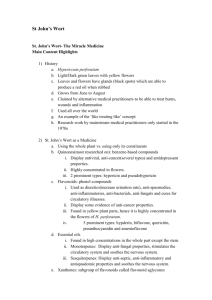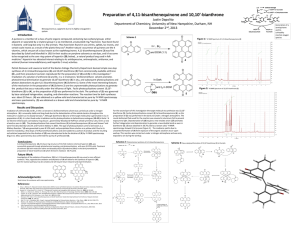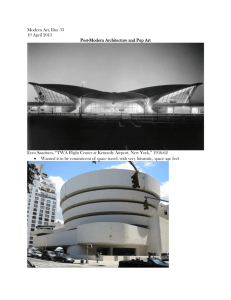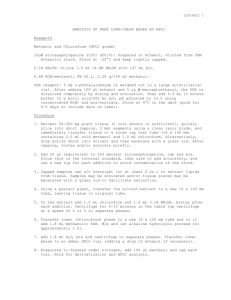The Synthesis and Characterization of Ferrocene
advertisement
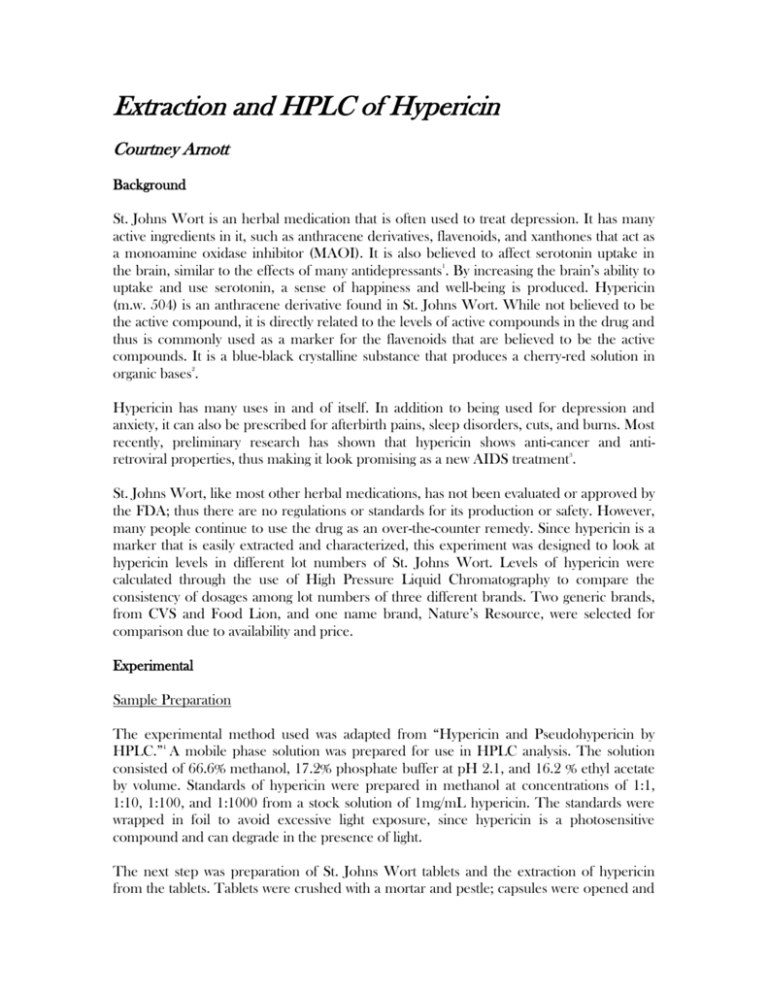
Extraction and HPLC of Hypericin Courtney Arnott Background St. Johns Wort is an herbal medication that is often used to treat depression. It has many active ingredients in it, such as anthracene derivatives, flavenoids, and xanthones that act as a monoamine oxidase inhibitor (MAOI). It is also believed to affect serotonin uptake in the brain, similar to the effects of many antidepressants1. By increasing the brain’s ability to uptake and use serotonin, a sense of happiness and well-being is produced. Hypericin (m.w. 504) is an anthracene derivative found in St. Johns Wort. While not believed to be the active compound, it is directly related to the levels of active compounds in the drug and thus is commonly used as a marker for the flavenoids that are believed to be the active compounds. It is a blue-black crystalline substance that produces a cherry-red solution in organic bases2. Hypericin has many uses in and of itself. In addition to being used for depression and anxiety, it can also be prescribed for afterbirth pains, sleep disorders, cuts, and burns. Most recently, preliminary research has shown that hypericin shows anti-cancer and antiretroviral properties, thus making it look promising as a new AIDS treatment3. St. Johns Wort, like most other herbal medications, has not been evaluated or approved by the FDA; thus there are no regulations or standards for its production or safety. However, many people continue to use the drug as an over-the-counter remedy. Since hypericin is a marker that is easily extracted and characterized, this experiment was designed to look at hypericin levels in different lot numbers of St. Johns Wort. Levels of hypericin were calculated through the use of High Pressure Liquid Chromatography to compare the consistency of dosages among lot numbers of three different brands. Two generic brands, from CVS and Food Lion, and one name brand, Nature’s Resource, were selected for comparison due to availability and price. Experimental Sample Preparation The experimental method used was adapted from “Hypericin and Pseudohypericin by HPLC.”4 A mobile phase solution was prepared for use in HPLC analysis. The solution consisted of 66.6% methanol, 17.2% phosphate buffer at pH 2.1, and 16.2 % ethyl acetate by volume. Standards of hypericin were prepared in methanol at concentrations of 1:1, 1:10, 1:100, and 1:1000 from a stock solution of 1mg/mL hypericin. The standards were wrapped in foil to avoid excessive light exposure, since hypericin is a photosensitive compound and can degrade in the presence of light. The next step was preparation of St. Johns Wort tablets and the extraction of hypericin from the tablets. Tablets were crushed with a mortar and pestle; capsules were opened and the plastic casings discarded. 750 mg St. Johns Wort powder was mixed with 40 mL methanol. The flasks were sonicated for 15 minutes to completely dissolve the powder. The solution was then diluted to volume. A 10 mL aliquot was removed and centrifuged at 3400 rpm for 5 minutes to separate the liquid from excess tablet material. The supernatant was removed to a 50 mL beaker. The procedure was repeated to give a total volume of 10 mL extracted sample. The beakers were covered with plastic wrap and exposed to fluorescent light for 30 minutes to prepare for analysis. The beakers were then covered with aluminum foil and stored in a dark place until ready for injection. HPLC Analysis Chromatography analysis was run using two Waters 510 HPLC Pumps, a Waters 600s Controller, and a Waters 996 Photodiode Array Detector. The stationary phase was a Nova-Pak C18 3.9x150mm column, and the mobile liquid phase was a solution of 66.6% methanol, 17.2% phosphate buffer (pH 2.1) and 16.2% ethyl acetate. HPLC pumps were primed with filtered methanol according to the procedure described by S. Piepho and M. Moshier.5 The pumps were then switched over to filtered mobile phase solution via an equilibrate process. A 50 uL sample of hypericin extract was injected and run through the HPLC for 10 minutes. The obtained peak, at approximately 6 minutes, was integrated and the areas fitted to a standard concentration curve to determine the concentration in each sample. Results/Conclusions All lot numbers of St. Johns Wort showed some variation from the actual amounts of hypericin said to be contained within the tablet (30 ppm). Concentration (ppm) CVS Food Lion 31.63 25.18 24.27 22.97 25.38 24.46 Nature's Resource 34.06 37.79 38.48 Table 1. Concentrations of hypericin in St. Johns Wort samples. Statistical analysis was conducted using Microsoft Excel to calculate the average ppm for each brand and the average deviation for the samples from the average concentration. The average deviation was then tripled to find the daily deviation from the average that can be expected from each brand, since all brands recommended taking the tablets three times a day. Average ppm AveDeviation DailyDeviation CVS Food Lion 27.03 3.07 9.21 24.03 0.87 2.61 Nature's Resource 36.78 1.81 5.43 Table 2. Average concentrations and statistical deviations. The daily deviation was added and subtracted to the average concentration of hypericin to show the range of concentrations that could be ingested in one day’s worth of medication. High Dose Low Dose CVS Food Lion 90.29 71.87 75.41 70.21 Nature's Resource 115.76 104.90 Table 3. Range of concentrations of hypericin in daily dosage. The Food Lion brand St. Johns Wort showed the most consistent dose among different lot numbers, with a range of 5.2 ppm between the high dose and the low dose. The CVS brand showed the highest variation, with a range of 18.42 ppm. The brand name Nature’s Resource was in the middle, with a range of 10.86 ppm. Based on these variations, FDA evaluation would be necessary to assure safe and consistent dosages for patients taking this medication. Further research in this area is necessary, including repeating this experiment with trials of a single lot number to determine how much of the variation can be expected from the experimental method, and comparing these results to a medication that is regulated by the FDA to determine how much variation can be expected from the industry standard. Endnotes 1. “Hypericum Perforatum.” PDR for Herbal Medicines, p. 906. 2. “Hypericin.” DialogueWeb. www.dialogueweb.com (accessed 2-9-00). 3. “St. Johns Wort.” Woodland Publishing, Inc. www.nutraceutical.com/education (accessed 4-26-00). 4. “Hypericin and Pseudohypericin by HPLC.” Institute for Nutraceutical Advancement – Methods. www.nutraceuticalinstitute.com/methods/index.html (accessed 4-4-00). 5. “HPLC Set-up.” S. Piepho and M. Moshier, Sweet Briar College. 3-28-01. Figures Hypericin Standard Concentration Curve 1400 y = 5E-05x + 19.737 R2 = 0.9985 1200 Concentration (ppm) 1000 800 600 400 200 0 0 5000000 10000000 15000000 20000000 25000000 30000000 Integral Area Figure 1. Hypericin Standard Concentration Curve. Figure 2. Comparison of ppm Between St. Johns Wort Samples. (Red = Nature’s Resource Samples, Yellow = Food Lion Samples, Blue = CVS Samples)
